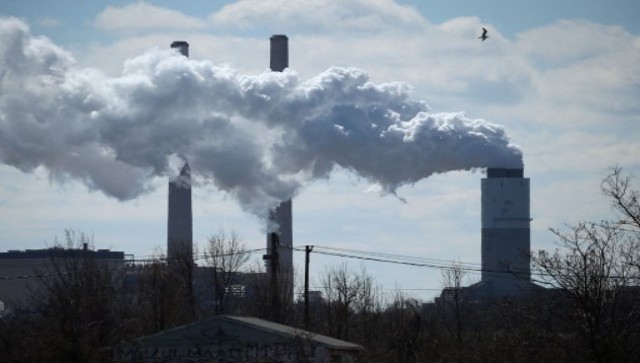The impacts of
climate change are now more stark and tangible than ever. There are reports of cyclones, hurricanes, hotter temperatures,
drought , more frequent wildfires, rising sea levels, melting glaciers, and flooding across the world. It has become challenging for humans and wild animals to survive due to climate change. A list of the top 50 countries that face the most danger from climate change in 2050 was published by the climate risk specialist XDI Cross Dependency Initiative in light of the growing alarms. The report states that China,
the United States , and India are where 80 per cent of the climate change danger exists. [caption id=“attachment_12184842” align=“alignnone” width=“640”] As per United Nations, long-term changes in temperature and weather patterns are referred to as climate change. AFP[/caption] India ranked third
India came in third place among the top 50 nations most in danger from the effects of climate change in 2050, according to the assessment report. While China has 26 high-risk states, the US has five, and India has nine of them. The most vulnerable states in India are Punjab, Bihar, Uttar Pradesh, Maharashtra, Rajasthan, Tamil Nadu, Gujarat, Kerala, and Assam, with Mumbai, the nation’s financial and commercial hub, ranking highly among them. Also read: Its moon’s turn to save Earth from global warming. Know how Other countries at risk China dominates the ranking, with 16 of the 20 global regions that are most at risk from climate change. As per the report, this might have significant global impacts as well. As per the report, some of the most significant manufacturing hubs in the world are located in the regions of China that are vulnerable to extreme weather and rising water levels. [caption id=“attachment_12184832” align=“alignnone” width=“640”]
China, the US, and India are where 80 per cent of the climate change danger exists. AP[/caption] The most affected provinces in China, whose states top the ranking, are mainly found in the east and south, near the floodplains and deltas of the Yangtze and Pearl Rivers. According to the survey, Jiangsu and Shandong, two of China’s major sub-national economies, rank first globally in terms of climate change risk. India Today quoted XDI CEO Rohan Hamden as saying, “The shift of global manufacturing to Asia has driven a substantial increase in infrastructure investment in already vulnerable regions throughout China, making it more susceptible to the impacts of climate change.” “Infrastructure investment has tended to be concentrated in areas that have traditionally been very high-risk - river deltas, coastal zones, and relatively flat areas,” he added. With 18 states ranking among the top 100,
the US has the second-most high-risk states after China. The most affected states in the US are the economically important California, Texas, and Florida. China, India, and the US collectively account for more than half of the states and provinces in the top 100. Brazil, Pakistan, and Indonesia are some of the other nations in the top 50 having several provinces and states. Significance of the survey In order to evaluate the potential economic damage that temperature rises could cause by 2050, XDI Cross Dependency examined over 2,600 regions throughout the world using climate models in conjunction with weather and environmental data. The projected effects of extreme weather and
climate change , such as flooding, forest fires, and sea level rise, on the built environment were examined. According to India Today, XDI CEO Rohan Hamden said in a statement, “This is the first time there has been a physical climate risk analysis focused exclusively on the built environment, comparing every state, province, and territory in the world.”
“Since extensive built infrastructure generally overlaps with high levels of economic activity and capital value it is imperative that the physical risk of climate change is appropriately understood and priced,” he explained.
Karl Mallon, XDI’s co-founder said, “While climate is likely to become increasingly decisive when it comes to determining the flow of capital, it remains to be seen whether it will deter investment in more vulnerable regions.” “There is a lot to be done to work out which areas in the world are potentially adaptable and defendable, and which are probably the areas we will see abandoned in due course,” Mallon added.
**Also read: Fighting climate change the Bharat way: Vedas hold the key** Climate change As per United Nations, long-term changes in temperature and weather patterns are referred to as climate change. These changes could be caused by natural processes, such as variations in the solar cycle. But since the 1800s, human activities—primarily the combustion of fossil fuels like coal, oil, and gas—have been the primary cause of climate change. Fossil fuel combustion produces greenhouse gas emissions that serve as a blanket around the planet, trapping heat from the sun and increasing temperatures. [caption id=“attachment_12184872” align=“alignnone” width=“640”] The impacts of climate change are now more stark and tangible than ever. AFP[/caption] It explained carbon dioxide and
methane are two examples of greenhouse gas emissions that are contributing to climate change. They are produced, for instance, while burning coal or gasoline to heat a building. Carbon dioxide can also be released during forest and land clearing. Methane emissions are primarily produced by waste landfills. Among the major emitters are energy, industry, transportation, buildings, agriculture, and land use. According to World Health Organisation (WHO), climate change is the single biggest health threat that humanity is facing. “Climate change affects the social and environmental determinants of health – clean air, safe drinking water, sufficient food and secure shelter,” it said. WHO predicted that between 2030 and 2050, climate change could cause approximately 250 000 additional deaths per year, from malnutrition, malaria, diarrhoea and heat stress. With inputs from agencies Read all the
Latest News ,
Trending News ,
Cricket News ,
Bollywood News , India News and
Entertainment News here. Follow us on
Facebook,
Twitter and
Instagram.


)

)
)
)
)
)
)
)
)



